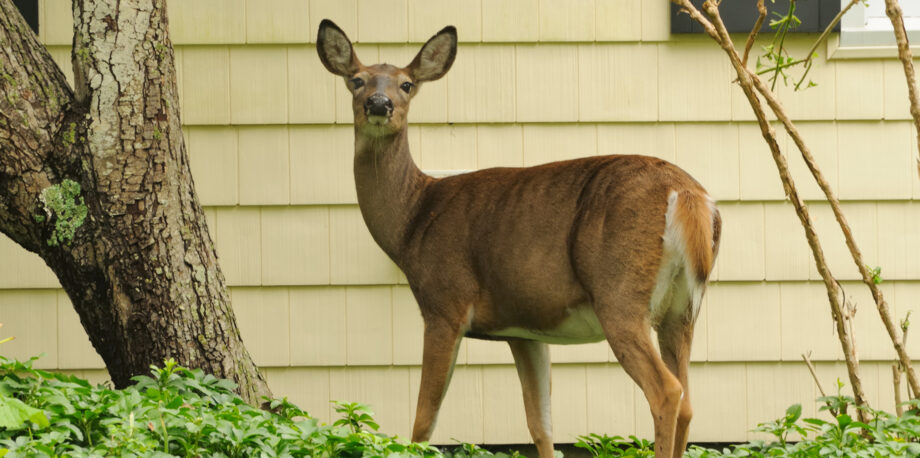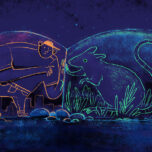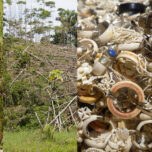July 10, 2020 — Wild and domestic animals have bestowed on humans up to 75% of our infectious diseases. These zoonoses include some of the most fearsome in human history: the plague, 1918 Spanish influenza, AIDS and Ebola.
Many, like Covid-19, first detected in central China late last year, explode from the teeming cities of developing countries in Asia. But deadly and debilitating zoonotic diseases emerge in countries all over the world. Some appear to have developed in North America. Others came from elsewhere but continue to lurk in human or animal populations in the United States. According to the U.S. Centers for Disease Control and Prevention, the most threatening include West Nile virus, salmonellosis, plague, rabies and Lyme disease.
“The global trends of population growth, economic growth, urban growth, and globalization — those are the factors that are driving much of this emergence,” says Duane J. Gubler, emeritus professor in the Emerging Infectious Diseases (EID) Signature Research Programme at Duke-NUS Medical School in Singapore.
Hunting for Trouble
The tale of a zoonotic disease begins with an animal host, and some species are more likely hosts than others. Rodents, bats and primates harbor three-quarters of known zoonotic viruses. Domestic animals also pose a risk.
For such diseases to spill over to humans, hosts must cross paths with people. Some live in our midst. Many serve as food.
Hunting was probably the first human activity that spread disease from animals to humans. And it’s still a risk today. Scientists believe Ebola may have infected humans hunting animal hosts such as primates.
In North America, hunters risk contracting brucellosis from wild hogs and avian flu from waterfowl (though the number of cases appears to be very low). One of the most alarming developments is the spread of chronic wasting disease (CWD) in white-tailed deer.
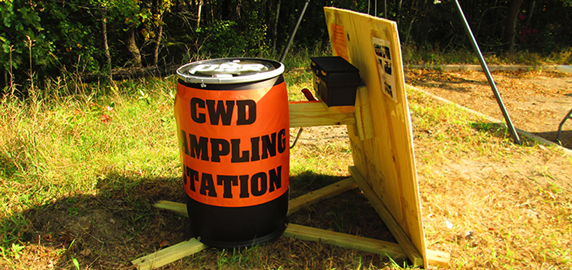
Natural resources agencies in some states test harvested deer in an attempt to limit the spread of chronic wasting disease. Photo courtesy of MN DNR
CWD is a fatal-to-deer neurodegenerative disease caused by an abnormally folded cell-surface protein called a prion. First observed in captive deer at a Colorado government research facility in the late 1960s, it was later described by Colorado State University graduate student Beth S. Williams, who became one of the foremost experts on the disease.
“We don’t know if it had been around prior to that because no one was looking,” says Debbie McKenzie, associate professor at the Centre for Prions and Protein Folding Diseases at the University of Alberta. Hunters and wildlife managers fear that transfer of deer, elk and other closely related ungulates between captive herds has spread the disease to wild animals. The disease now infects wild deer in least 24 states and two Canadian provinces.
It’s not clear if humans can catch CWD from deer. A similar prion disease in cattle, mad cow disease, is associated with fatal disease in humans. The equivalent in sheep, scrapie, does not. Proof of transmission to humans would be devastating for deer hunters — and for efforts to control the burgeoning number of white-tailed deer in the nation’s woodlands and suburbs.
“One of the huge factors for CWD is deer density, which I think is why we saw it spread as rapidly and get to the high levels of prevalence in Wisconsin that we see, just because the deer density there is amazingly high,” says McKenzie. In one Wisconsin county, more than half of bucks sampled were infected.
Disease on the Wing
Domestication and factory farming have brought a host of animals into close association with humans and unleashed zoonotic spillovers in the U.S. as well.
The 2009 H1N1 flu pandemic, which killed more than 12,000 people in the United States, originated in hog farms in Mexico. Avian influenza spread through U.S. poultry flocks and wild birds in 2014 and 2015, though the North American strains of avian flu only rarely infect people.
Domestic flocks also harbored West Nile virus, which traveled to North America and then spread with lightning speed across the continent thanks to flocks of migrating wild birds, says Gubler.
First isolated in Africa in 1937, West Nile wasn’t considered much of a public health problem — for humans or birds. “Something happened to that virus in the mid-1990s that caused it to start spreading,” says Gubler. “My speculation is that the virus genetically changed.”
The virus caused outbreaks in the Mediterranean, including in domestic flocks of geese and humans in Israel. Soon, a near-exact copy of the Israeli strain of virus showed up in Queens, New York. “The question is, ‘How did it get there?,’” Gubler says. The virus might have crossed the Atlantic by mosquito or captive bird in cargo, by migrating wild birds, or by an infected human.

Capable of infecting hundreds of species, West Nile virus spreads readily between domestic and wild birds. Photo © iStockphoto.com | Tatiana Terekhina
Then the race was on. By examining dead birds, epidemiologists traced the spread of West Nile across the continent. By 2000, the virus spread along the Eastern Seaboard. By 2001, it had invaded the Midwest and South. By 2002, it had crossed the Great Plains clear to the West Coast. Migrating birds had carried the virus north and south along the major flyways. A short movement to the west would carry it into a new flyway to spread the next migration season. “If you look at those flyways, it fits perfectly with the way the virus moved across the country,” says Gubler.
Now, West Nile virus is the No. 1 source of mosquito-borne disease in the continental United States and has been found in more than 300 species of birds in North America. Most infected people have no symptoms. Fewer than 1% develop serious, sometimes fatal, illness.
“There are environmental factors that influence this,” says Gubler. Warmer winters are conducive to a healthy mosquito crop. Density of domestic birds, human residents, and wild birds aid the spread. Given that the virus can infect hundreds of birds species and dozens of non-avian species — from mountain goats to alligators — it’s hard to imagine how to eradicate the pathogen from its many reservoirs. “All of these factors influence transmission dynamics,” Gubler says. “And it varies with the different viruses and the different biology of those viruses.”
Fragmented Landscapes
Zoonotic diseases can erupt from changes in land use such as clear-cutting and urban expansion — “destroying habitats and ruining ecosystems,” in the words of a recent article in The New York Times Magazine.
But reality can be more nuanced and paradoxical. Lyme disease provides an example.
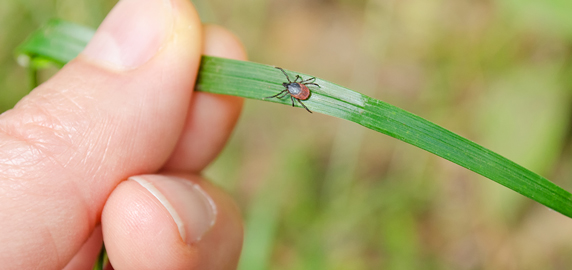
Blacklegged ticks, also known as deer ticks, are notorious for transmitting the bacterium that causes Lyme disease from animals to humans. Photos © iStockphoto.com | Kerrick
Named for Lyme, Connecticut, where the first outbreak was recognized and described in the 1970s, the tickborne disease has grown to more than 30,000 cases reported each year and an incidence perhaps 10 times greater. It’s caused by the bacterium Borrelia burgdorferi (and, rarely, Borrelia mayonii), carried by the blacklegged tick between a variety of mammalian and avian hosts, especially white-footed mice and white-tailed deer. Humans bitten by an infected tick may suffer a distinctive bull’s-eye rash, fever, headache, fatigue, arthritis, and nerve and heart damage.
Despite its recent emergence, Lyme disease has been around a long time — since before the height of the most recent Ice Age more than 20,000 years ago, according to Katharine Walter, postdoctoral research fellow in infectious diseases at Stanford University. Walter is the lead author of a study published in Nature Ecology and Evolution that examined mutations in the genome of samples of B. burgdorferi collected at various sites between 1984 and 2013. The diversity of the samples “is not consistent with a recent introduction or recent origin in North America,” she says. “That indicates that the recent emergence since the early ’70s is not due to an introduction or some sort of mutation in the bacteria. It’s instead due to ecological change.”
Colonists and settlers cleared forests, first in New England, then the Great Lakes. Population grew. Hunting increased unabated. White-tailed deer, which provide a vital blood meal for the adult tick, dropped from an estimated 30 million before colonization to nearly zero by 1900. The ticks were scarce and the disease unknown.
But in recent decades, forests regrew. Deer hunting was more effectively regulated. Deer rebounded, possibly exceeding their numbers in precolonial times. The increasingly wooded city edges, suburbs, and small towns created a patchwork of habitat where hunting wasn’t allowed and whitetails, mice, and ticks flourished.

Wooded residential areas like this one in Old Lyme, Connecticut, create patchworks of habitat in which ticks that carry Lyme disease flourish. Photo courtesy of Pi.1415926535 from Wikimedia, licensed under CC BY-SA 3.0
“In creating these fragmented suburban landscapes,” Walter says, “we basically constructed the optimal environment for the spread of tick-borne pathogens.”
Lyme will probably continue to be a problem until the day we dramatically remake our suburbs to get rid of the fragmented lands so beloved by deer and the grassy fringes conducive to mice and ticks—the very things that make suburbs appealing to so many people.
What’s Changed
As Lyme disease illustrates, zoonotic diseases are not a modern problem. But modern civilization creates conditions to trigger outbreaks and exacerbate their effects.
“We’ve always had these potential spillover events that can come from wild animals or domestic animals to humans,” says Michael Osterholm, director of the Center for Infectious Diseases Research and Policy at the University of Minnesota. “But what has happened is the intensity of that has changed.”
Domestic chickens now number more than 23 billion and outweigh all other birds. In the United States and elsewhere, the trend is toward large confinement operations with many animals crowded together. At the same time, we’ve made our suburbs and semi-wild areas more attractive to wildlife. Trade and travel move stuff around as never before.
“What’s changed is opening up the world to this human-animal interface in a way we’ve never done before, and corporate agriculture,” Osterholm says. “The two combined have really been dramatic.”
So we are poised for another epidemic, whether the evolution and outbreak of an existing disease or the emergence of something completely novel. And it’s clear that’s not something that can only happen in some country far away.
But in the long run, here or abroad makes little difference, says Gubler.
“Every one of those cities has an airport,” he says. “So it greatly increases the probability that a virus like coronavirus can get on a plane and fly.”
UPDATED 07.16.20 A quote from Debbie McKenzie was deleted.
Related Posts
Ensia shares solutions-focused stories free of charge through our online magazine and partner media. That means audiences around the world have ready access to stories that can — and do — help them shape a better future. If you value our work, please show your support today.
Yes, I'll support Ensia!